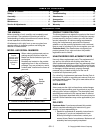GB - 7
DO NOT transport machine while engine is running.
Keep unit free of grass clippings, leaves, and other
debris. Clean up oil or fuel spills.
This product is equipped with an internal combustion
type engine. DO NOT use unit on or near any
unimproved, forest-covered or brush covered land unless
exhaust system is equipped with a spark arrester
meeting applicable local, state or federal laws. A spark
arrester, if it is used, must be maintained in effective
working order by operator.
Fuel is highly flammable and its vapors are explosive.
Handle with care. Use an approved fuel container.
NO smoking, NO sparks, NO flames. ALWAYS allow
engine to cool before servicing.
NEVER fill fuel tank when engine is running or hot from
operation.
NEVER fill or drain fuel tank indoors.
NEVER overfill fuel tank.
Replace fuel cap securely and clean up spilled fuel.
NEVER fill containers inside a vehicle or on a truck or
trailer bed with a plastic liner. Always place containers on
the ground away from your vehicle before filling.
When practical, remove gas-powered equipment from
the truck or trailer and refuel it on the ground. If this is not
possible, then refuel such equipment on a trailer with a
portable container, rather than from a gasoline dispenser
nozzle.
Keep the nozzle in contact with the rim of the fuel tank or
container opening at all times until fueling is complete.
Do not use a nozzle lock-open device.
If fuel is spilled on clothing, change clothing immediately.
Avoid Electric Shock. Objects contacting both battery
terminals at the same time may result in injury and unit
damage. DO NOT reverse battery connections.
Explosive Gases from battery can cause death or serious
injury. Poisonous battery fluid contains sulfuric acid and
its contact with skin, eyes or clothing can cause severe
chemical burns.
NO flames, NO sparks, NO smoking near battery.
ALWAYS wear safety glasses and protective gear near
battery.
DO NOT TIP battery beyond a 45˚ angle in any direction.
ALWAYS keep batteries out of reach of children.
Battery posts, terminals and related accessories contain
lead and lead compounds, chemicals known to the State
of California to cause cancer and reproductive harm.
Wash hands after handling.
Reverse connections may result in sparks which can
cause serious injury. Always connect positive (+) lead of
charger to positive (+) terminal, and negative (-) lead to
negative (-) terminal.
ALWAYS disconnect negative (-) cable FIRST and
positive (+) cable SECOND. ALWAYS connect positive
(+) cable FIRST, and negative (-) cable SECOND.
A frozen battery can explode and result in death or
serious injury. DO NOT charge or jump start a battery
containing frozen fluid. Thaw the battery before putting on
a charger or jump starting.
ALWAYS keep protective structures, guards, and panels
in good repair, in place and securely fastened. NEVER
modify or remove safety devices.
DO NOT change engine governor settings or over-speed
engine.
Fumes from engine exhaust can cause injury or death.
DO NOT run engine in an enclosed area. Always provide
good ventilation.
ALWAYS maintain unit in safe operating condition.
Damaged or worn out muffler can cause fire or explosion.
Stop and inspect equipment if you strike an object or if
there is an unusual vibration. Repair, if necessary, before
restarting. Never make adjustments or repairs with the
engine running.
Mower blades are sharp and can cut you. Wrap the
blade(s) or wear gloves, and use extra caution when
servicing them. NEVER weld or straighten mower blades.
Rotation of one blade may cause rotation of the other
blades.
Check brake operation frequently. Adjust and service as
required.
Keep all hardware properly tightened.
Stored energy in springs can cause injury.
Maintain or replace safety and instruction labels, as
necessary.
Never store the machine or fuel container inside a
building where there is an open flame, such as a water
heater.
Allow engine to cool completely before storing in closed
area or covering unit.
For extended storage, clean unit thoroughly. See Engine
Manual for proper storage.
Use only attachments or accessories designed for your
unit.
Check attachment components frequently. If worn or
damaged, replace with manufacturer’s recommended
parts.


















